brake fluid CHEVROLET MONTE CARLO 2004 Owners Manual
[x] Cancel search | Manufacturer: CHEVROLET, Model Year: 2004, Model line: MONTE CARLO, Model: CHEVROLET MONTE CARLO 2004Pages: 416, PDF Size: 4.56 MB
Page 115 of 416
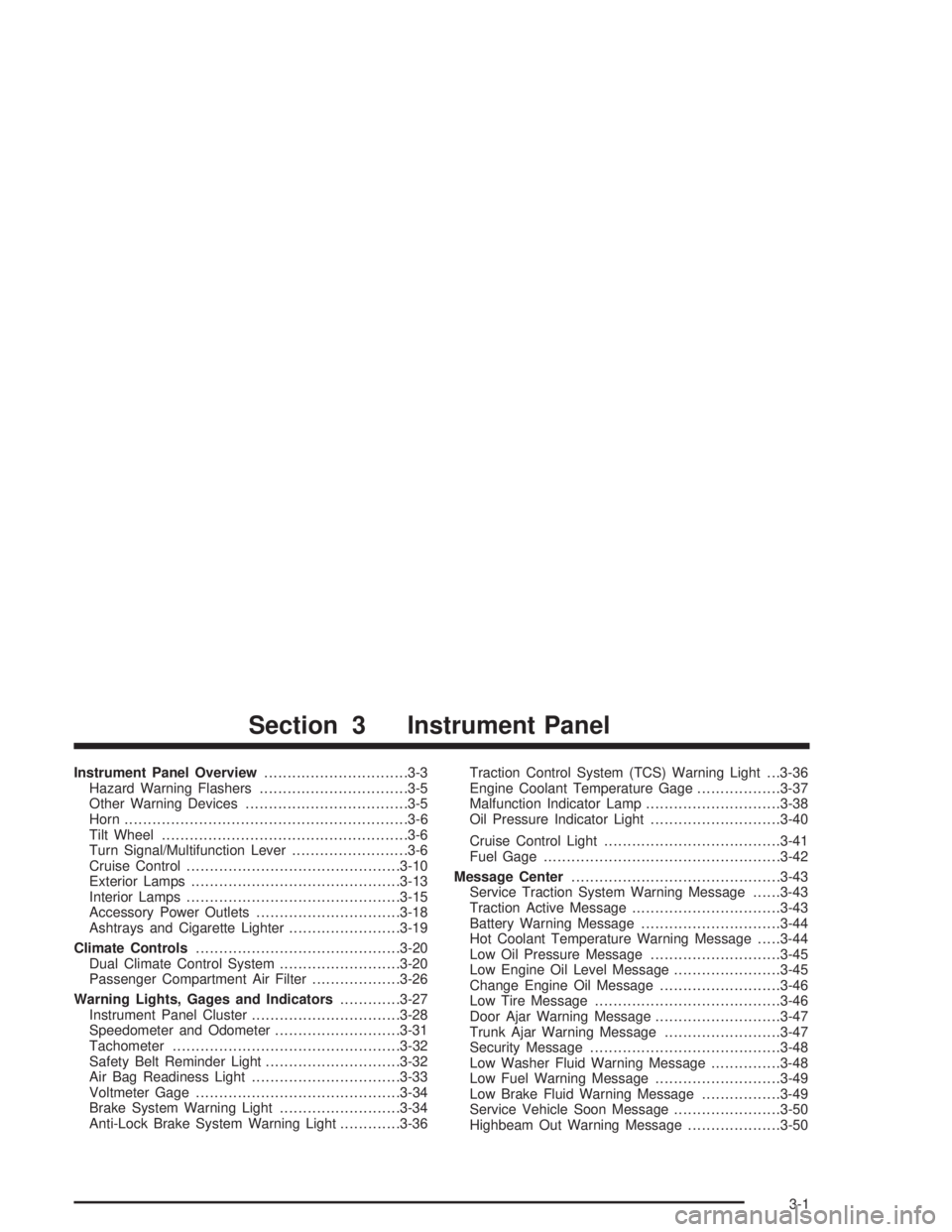
Instrument Panel Overview...............................3-3
Hazard Warning Flashers................................3-5
Other Warning Devices...................................3-5
Horn.............................................................3-6
Tilt Wheel.....................................................3-6
Turn Signal/Multifunction Lever.........................3-6
Cruise Control..............................................3-10
Exterior Lamps.............................................3-13
Interior Lamps..............................................3-15
Accessory Power Outlets...............................3-18
Ashtrays and Cigarette Lighter........................3-19
Climate Controls............................................3-20
Dual Climate Control System..........................3-20
Passenger Compartment Air Filter...................3-26
Warning Lights, Gages and Indicators.............3-27
Instrument Panel Cluster................................3-28
Speedometer and Odometer...........................3-31
Tachometer.................................................3-32
Safety Belt Reminder Light.............................3-32
Air Bag Readiness Light................................3-33
Voltmeter Gage............................................3-34
Brake System Warning Light..........................3-34
Anti-Lock Brake System Warning Light.............3-36Traction Control System (TCS) Warning Light . . .3-36
Engine Coolant Temperature Gage..................3-37
Malfunction Indicator Lamp.............................3-38
Oil Pressure Indicator Light............................3-40
Cruise Control Light......................................3-41
Fuel Gage...................................................3-42
Message Center.............................................3-43
Service Traction System Warning Message......3-43
Traction Active Message................................3-43
Battery Warning Message..............................3-44
Hot Coolant Temperature Warning Message.....3-44
Low Oil Pressure Message............................3-45
Low Engine Oil Level Message.......................3-45
Change Engine Oil Message..........................3-46
Low Tire Message........................................3-46
Door Ajar Warning Message...........................3-47
Trunk Ajar Warning Message.........................3-47
Security Message.........................................3-48
Low Washer Fluid Warning Message...............3-48
Low Fuel Warning Message...........................3-49
Low Brake Fluid Warning Message.................3-49
Service Vehicle Soon Message.......................3-50
Highbeam Out Warning Message....................3-50
Section 3 Instrument Panel
3-1
Page 149 of 416
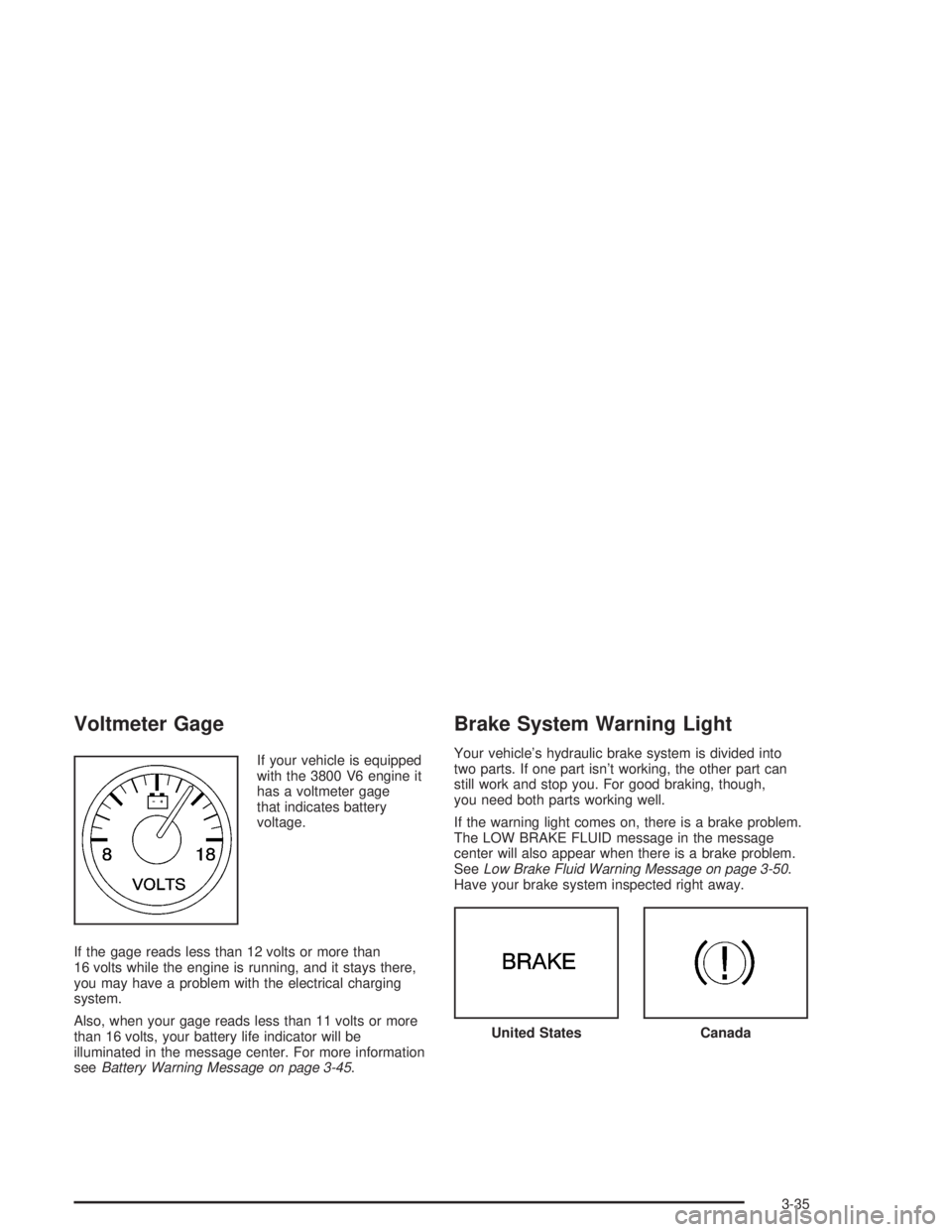
Voltmeter Gage
If your vehicle is equipped
with the 3800 V6 engine it
has a voltmeter gage
that indicates battery
voltage.
If the gage reads less than 12 volts or more than
16 volts while the engine is running, and it stays there,
you may have a problem with the electrical charging
system.
Also, when your gage reads less than 11 volts or more
than 16 volts, your battery life indicator will be
illuminated in the message center. For more information
seeBattery Warning Message on page 3-45.
Brake System Warning Light
Your vehicle’s hydraulic brake system is divided into
two parts. If one part isn’t working, the other part can
still work and stop you. For good braking, though,
you need both parts working well.
If the warning light comes on, there is a brake problem.
The LOW BRAKE FLUID message in the message
center will also appear when there is a brake problem.
SeeLow Brake Fluid Warning Message on page 3-50.
Have your brake system inspected right away.
United StatesCanada
3-35
Page 164 of 416
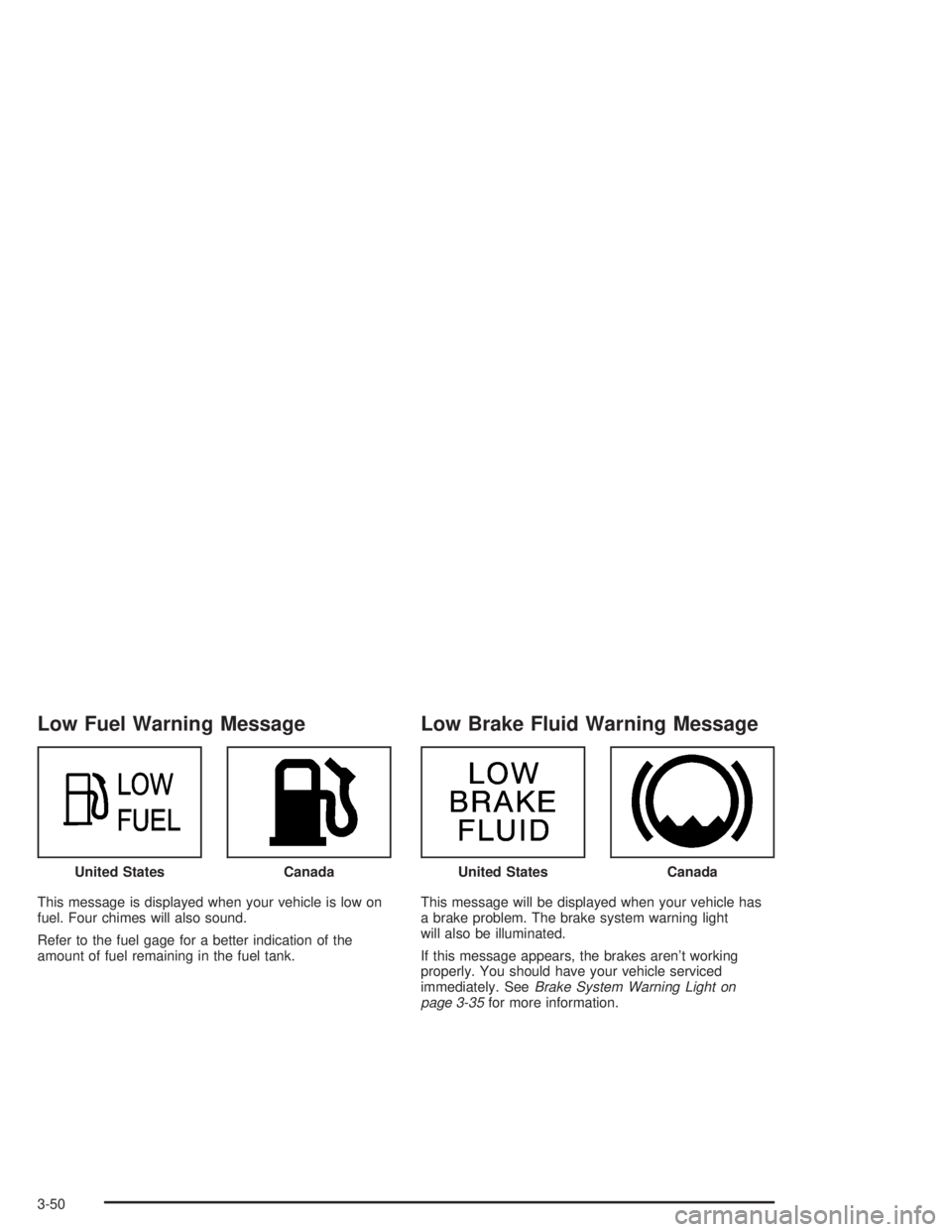
Low Fuel Warning Message
This message is displayed when your vehicle is low on
fuel. Four chimes will also sound.
Refer to the fuel gage for a better indication of the
amount of fuel remaining in the fuel tank.
Low Brake Fluid Warning Message
This message will be displayed when your vehicle has
a brake problem. The brake system warning light
will also be illuminated.
If this message appears, the brakes aren’t working
properly. You should have your vehicle serviced
immediately. SeeBrake System Warning Light on
page 3-35for more information. United States
CanadaUnited StatesCanada
3-50
Page 257 of 416
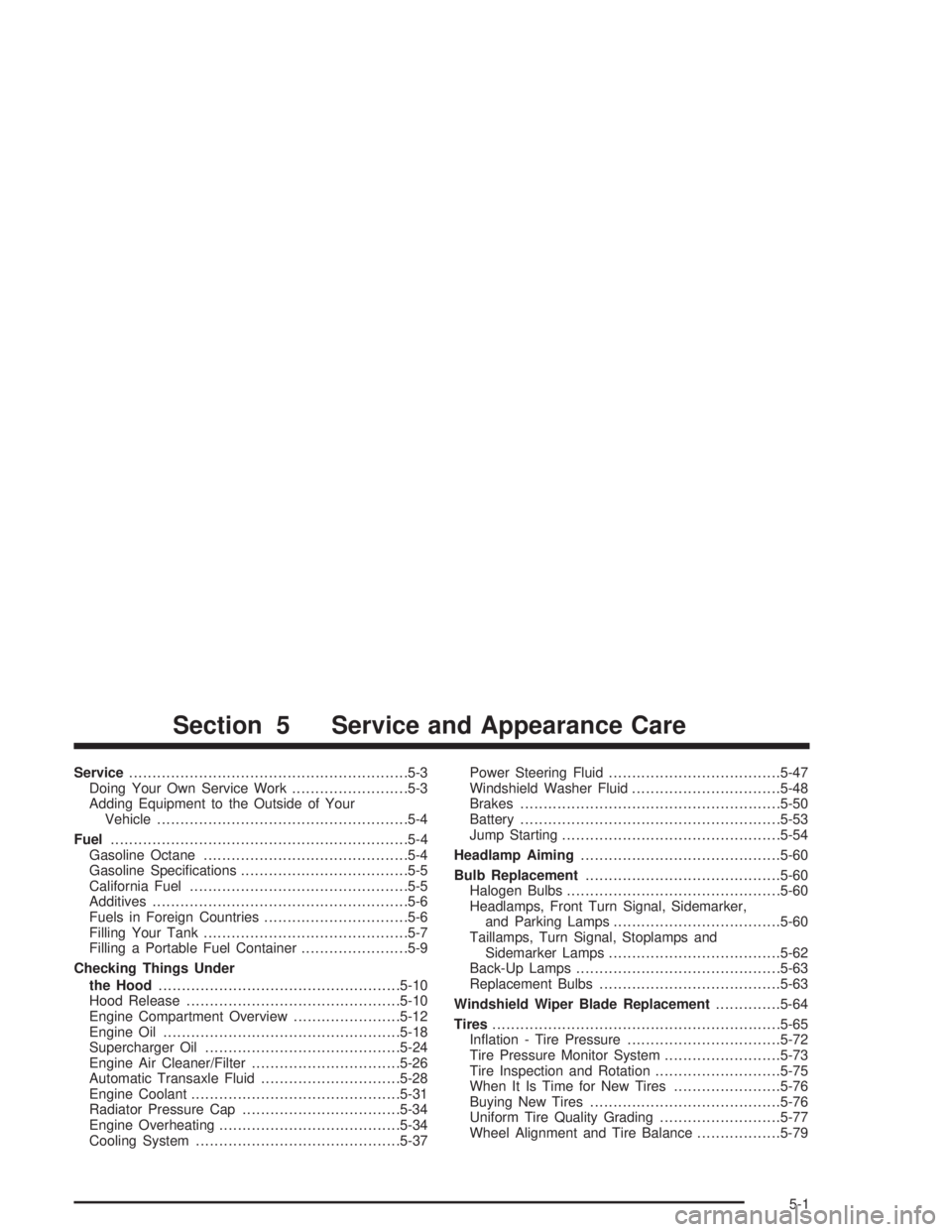
Service............................................................5-3
Doing Your Own Service Work.........................5-3
Adding Equipment to the Outside of Your
Vehicle......................................................5-4
Fuel................................................................5-4
Gasoline Octane............................................5-4
Gasoline Speci�cations....................................5-5
California Fuel...............................................5-5
Additives.......................................................5-6
Fuels in Foreign Countries...............................5-6
Filling Your Tank............................................5-7
Filling a Portable Fuel Container.......................5-9
Checking Things Under
the Hood....................................................5-10
Hood Release..............................................5-10
Engine Compartment Overview.......................5-12
Engine Oil...................................................5-18
Supercharger Oil..........................................5-24
Engine Air Cleaner/Filter................................5-26
Automatic Transaxle Fluid..............................5-28
Engine Coolant.............................................5-31
Radiator Pressure Cap..................................5-34
Engine Overheating.......................................5-34
Cooling System............................................5-37Power Steering Fluid.....................................5-47
Windshield Washer Fluid................................5-48
Brakes........................................................5-50
Battery........................................................5-53
Jump Starting...............................................5-54
Headlamp Aiming...........................................5-60
Bulb Replacement..........................................5-60
Halogen Bulbs..............................................5-60
Headlamps, Front Turn Signal, Sidemarker,
and Parking Lamps....................................5-60
Taillamps, Turn Signal, Stoplamps and
Sidemarker Lamps.....................................5-62
Back-Up Lamps............................................5-63
Replacement Bulbs.......................................5-63
Windshield Wiper Blade Replacement..............5-64
Tires..............................................................5-65
In�ation - Tire Pressure.................................5-72
Tire Pressure Monitor System.........................5-73
Tire Inspection and Rotation...........................5-75
When It Is Time for New Tires.......................5-76
Buying New Tires.........................................5-76
Uniform Tire Quality Grading..........................5-77
Wheel Alignment and Tire Balance..................5-79
Section 5 Service and Appearance Care
5-1
Page 269 of 416
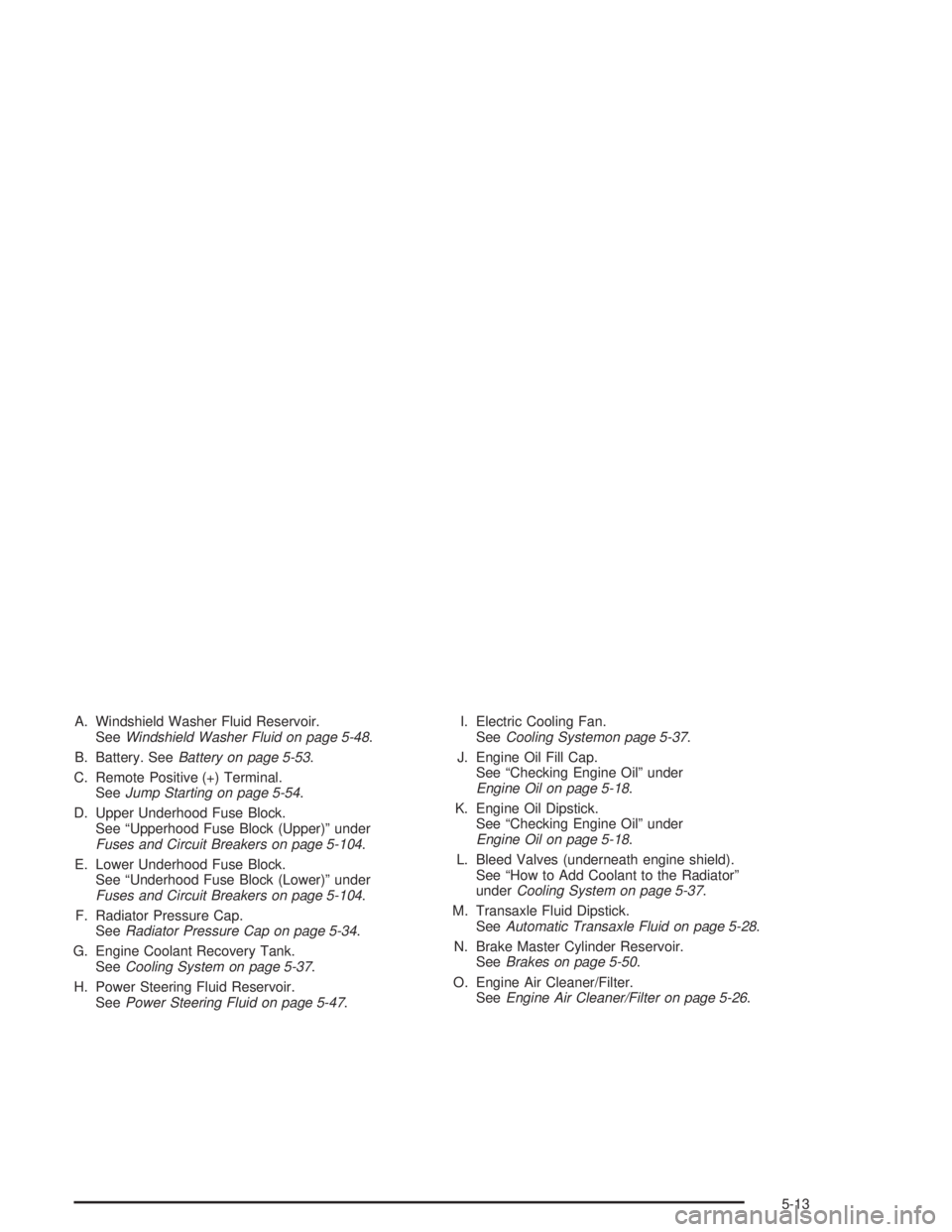
A. Windshield Washer Fluid Reservoir.
SeeWindshield Washer Fluid on page 5-48.
B. Battery. SeeBattery on page 5-53.
C. Remote Positive (+) Terminal.
SeeJump Starting on page 5-54.
D. Upper Underhood Fuse Block.
See “Upperhood Fuse Block (Upper)” under
Fuses and Circuit Breakers on page 5-104.
E. Lower Underhood Fuse Block.
See “Underhood Fuse Block (Lower)” under
Fuses and Circuit Breakers on page 5-104.
F. Radiator Pressure Cap.
SeeRadiator Pressure Cap on page 5-34.
G. Engine Coolant Recovery Tank.
SeeCooling System on page 5-37.
H. Power Steering Fluid Reservoir.
SeePower Steering Fluid on page 5-47.I. Electric Cooling Fan.
SeeCooling Systemon page 5-37.
J. Engine Oil Fill Cap.
See “Checking Engine Oil” under
Engine Oil on page 5-18.
K. Engine Oil Dipstick.
See “Checking Engine Oil” under
Engine Oil on page 5-18.
L. Bleed Valves (underneath engine shield).
See “How to Add Coolant to the Radiator”
underCooling System on page 5-37.
M. Transaxle Fluid Dipstick.
SeeAutomatic Transaxle Fluid on page 5-28.
N. Brake Master Cylinder Reservoir.
SeeBrakes on page 5-50.
O. Engine Air Cleaner/Filter.
SeeEngine Air Cleaner/Filter on page 5-26.
5-13
Page 271 of 416
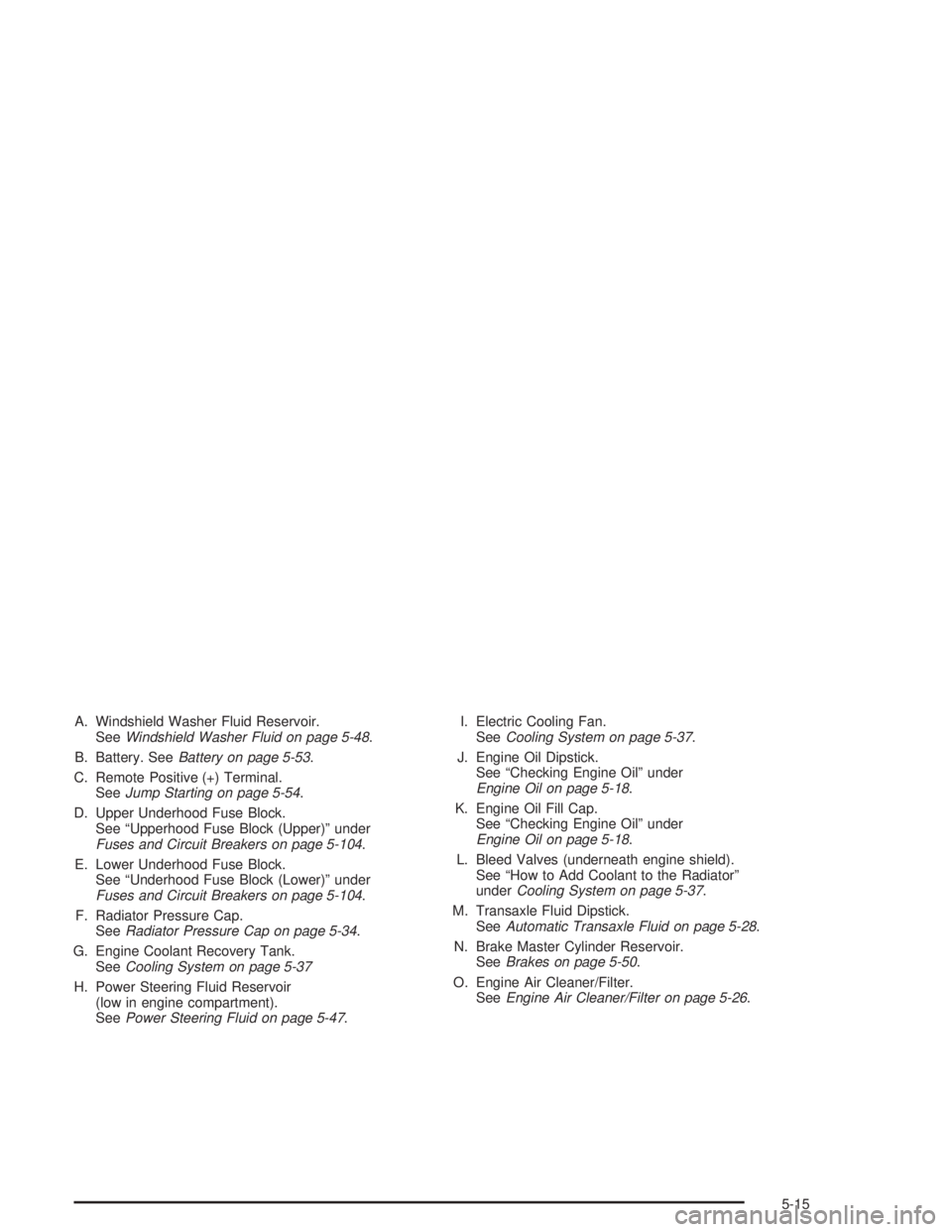
A. Windshield Washer Fluid Reservoir.
SeeWindshield Washer Fluid on page 5-48.
B. Battery. SeeBattery on page 5-53.
C. Remote Positive (+) Terminal.
SeeJump Starting on page 5-54.
D. Upper Underhood Fuse Block.
See “Upperhood Fuse Block (Upper)” under
Fuses and Circuit Breakers on page 5-104.
E. Lower Underhood Fuse Block.
See “Underhood Fuse Block (Lower)” under
Fuses and Circuit Breakers on page 5-104.
F. Radiator Pressure Cap.
SeeRadiator Pressure Cap on page 5-34.
G. Engine Coolant Recovery Tank.
SeeCooling System on page 5-37
H. Power Steering Fluid Reservoir
(low in engine compartment).
SeePower Steering Fluid on page 5-47.I. Electric Cooling Fan.
SeeCooling System on page 5-37.
J. Engine Oil Dipstick.
See “Checking Engine Oil” under
Engine Oil on page 5-18.
K. Engine Oil Fill Cap.
See “Checking Engine Oil” under
Engine Oil on page 5-18.
L. Bleed Valves (underneath engine shield).
See “How to Add Coolant to the Radiator”
underCooling System on page 5-37.
M. Transaxle Fluid Dipstick.
SeeAutomatic Transaxle Fluid on page 5-28.
N. Brake Master Cylinder Reservoir.
SeeBrakes on page 5-50.
O. Engine Air Cleaner/Filter.
SeeEngine Air Cleaner/Filter on page 5-26.
5-15
Page 273 of 416
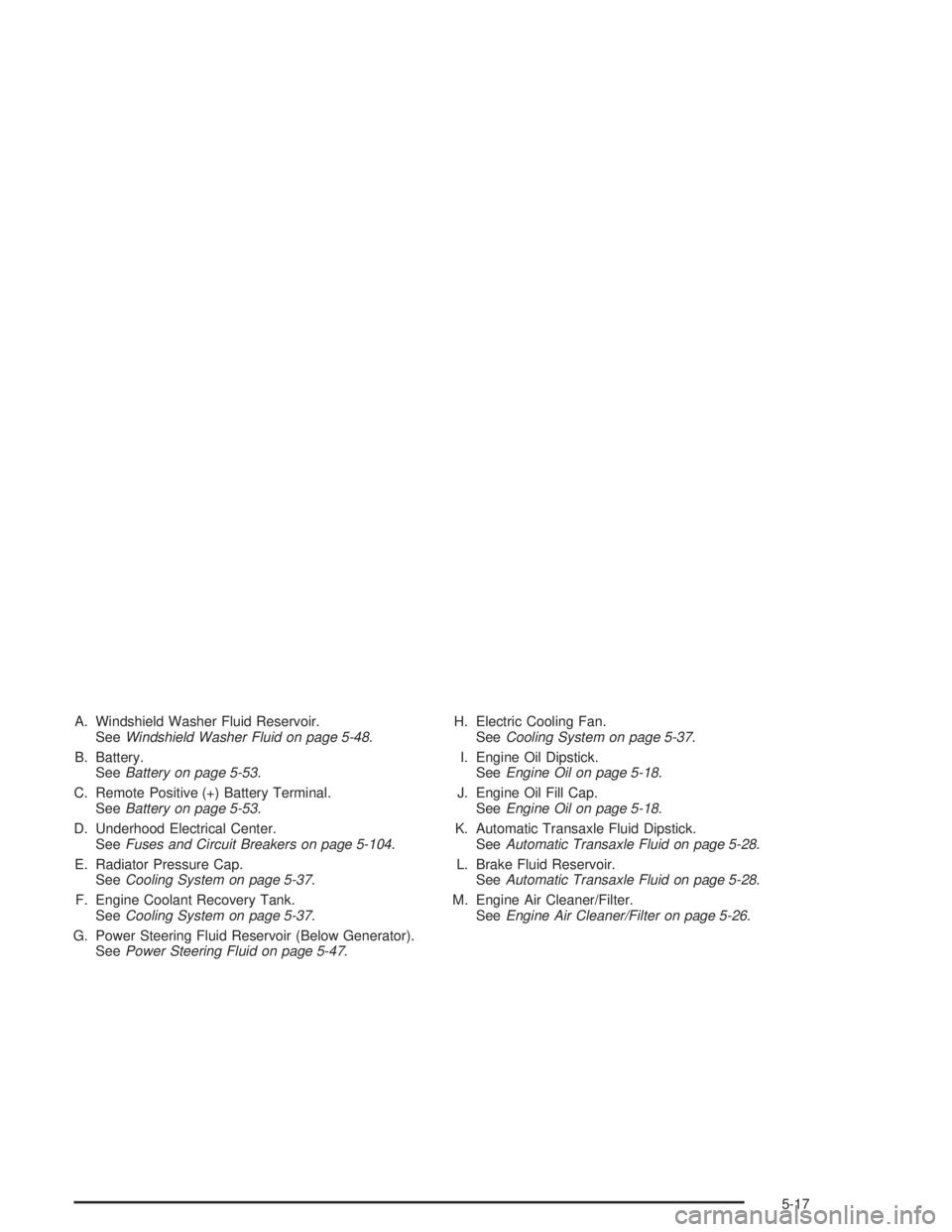
A. Windshield Washer Fluid Reservoir.
SeeWindshield Washer Fluid on page 5-48.
B. Battery.
SeeBattery on page 5-53.
C. Remote Positive (+) Battery Terminal.
SeeBattery on page 5-53.
D. Underhood Electrical Center.
SeeFuses and Circuit Breakers on page 5-104.
E. Radiator Pressure Cap.
SeeCooling System on page 5-37.
F. Engine Coolant Recovery Tank.
SeeCooling System on page 5-37.
G. Power Steering Fluid Reservoir (Below Generator).
SeePower Steering Fluid on page 5-47.H. Electric Cooling Fan.
SeeCooling System on page 5-37.
I. Engine Oil Dipstick.
SeeEngine Oil on page 5-18.
J. Engine Oil Fill Cap.
SeeEngine Oil on page 5-18.
K. Automatic Transaxle Fluid Dipstick.
SeeAutomatic Transaxle Fluid on page 5-28.
L. Brake Fluid Reservoir.
SeeAutomatic Transaxle Fluid on page 5-28.
M. Engine Air Cleaner/Filter.
SeeEngine Air Cleaner/Filter on page 5-26.
5-17
Page 285 of 416
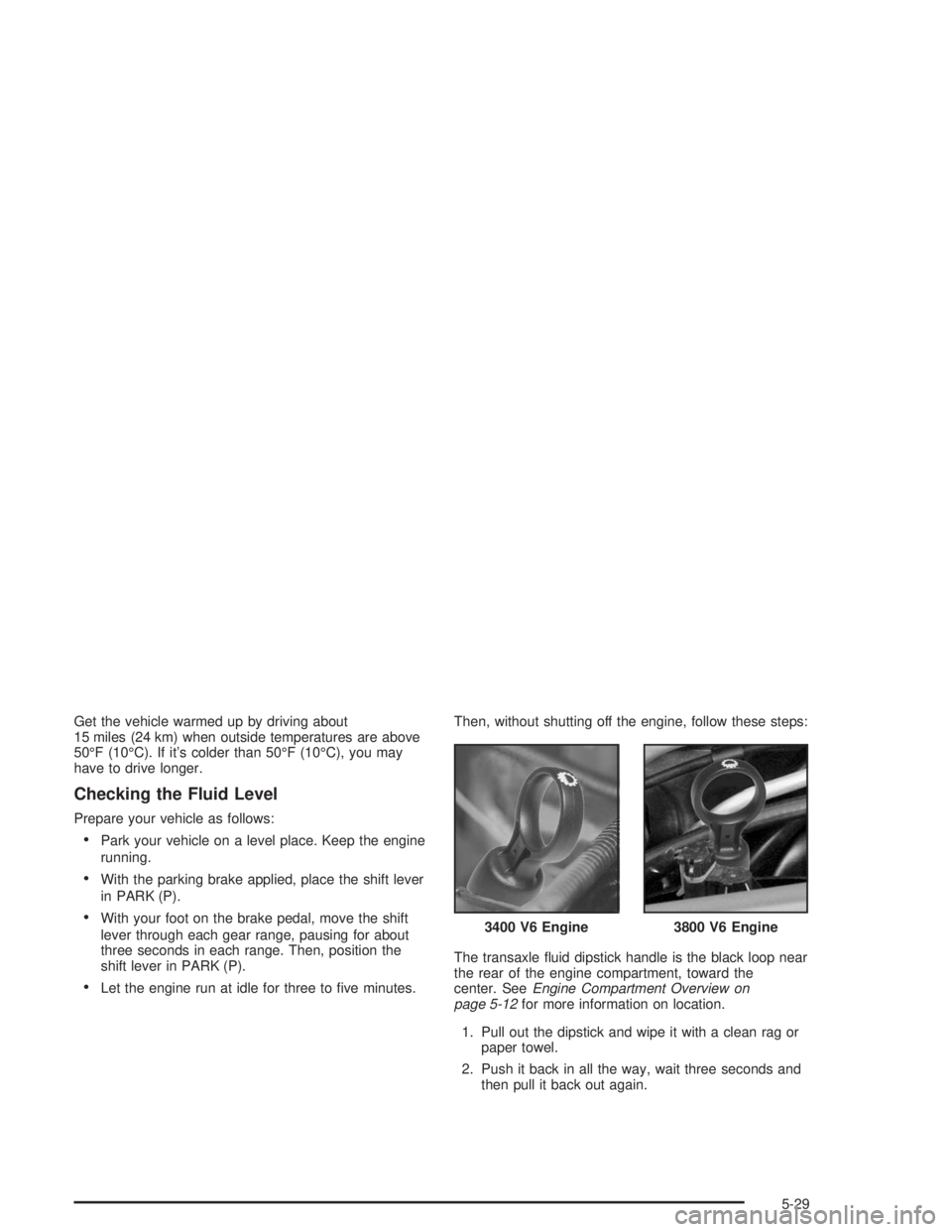
Get the vehicle warmed up by driving about
15 miles (24 km) when outside temperatures are above
50°F (10°C). If it’s colder than 50°F (10°C), you may
have to drive longer.
Checking the Fluid Level
Prepare your vehicle as follows:
Park your vehicle on a level place. Keep the engine
running.
With the parking brake applied, place the shift lever
in PARK (P).
With your foot on the brake pedal, move the shift
lever through each gear range, pausing for about
three seconds in each range. Then, position the
shift lever in PARK (P).
Let the engine run at idle for three to �ve minutes.Then, without shutting off the engine, follow these steps:
The transaxle �uid dipstick handle is the black loop near
the rear of the engine compartment, toward the
center. SeeEngine Compartment Overview on
page 5-12for more information on location.
1. Pull out the dipstick and wipe it with a clean rag or
paper towel.
2. Push it back in all the way, wait three seconds and
then pull it back out again.3400 V6 Engine
3800 V6 Engine
5-29
Page 306 of 416
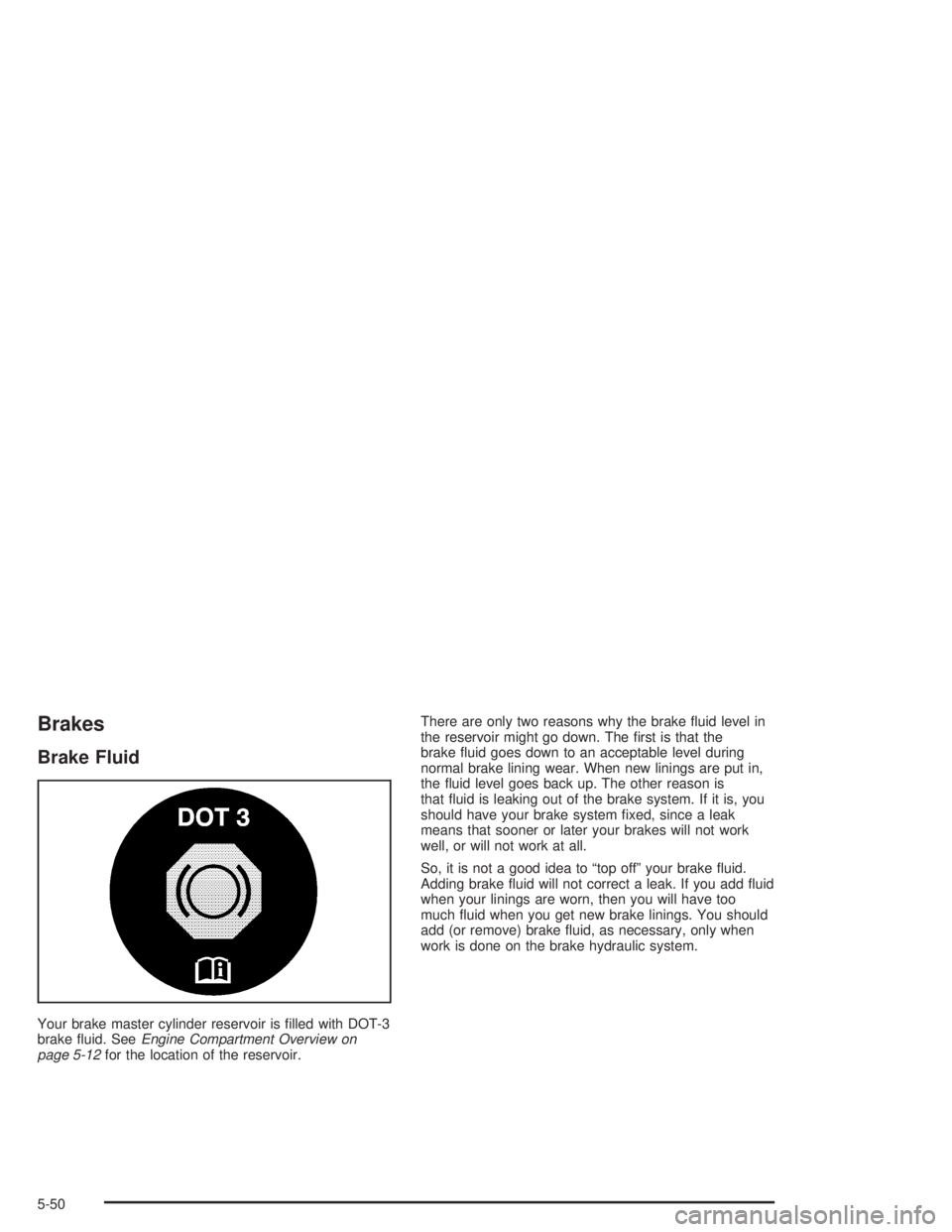
Brakes
Brake Fluid
Your brake master cylinder reservoir is �lled with DOT-3
brake �uid. SeeEngine Compartment Overview on
page 5-12for the location of the reservoir.There are only two reasons why the brake �uid level in
the reservoir might go down. The �rst is that the
brake �uid goes down to an acceptable level during
normal brake lining wear. When new linings are put in,
the �uid level goes back up. The other reason is
that �uid is leaking out of the brake system. If it is, you
should have your brake system �xed, since a leak
means that sooner or later your brakes will not work
well, or will not work at all.
So, it is not a good idea to “top off” your brake �uid.
Adding brake �uid will not correct a leak. If you add �uid
when your linings are worn, then you will have too
much �uid when you get new brake linings. You should
add (or remove) brake �uid, as necessary, only when
work is done on the brake hydraulic system.
5-50
Page 307 of 416
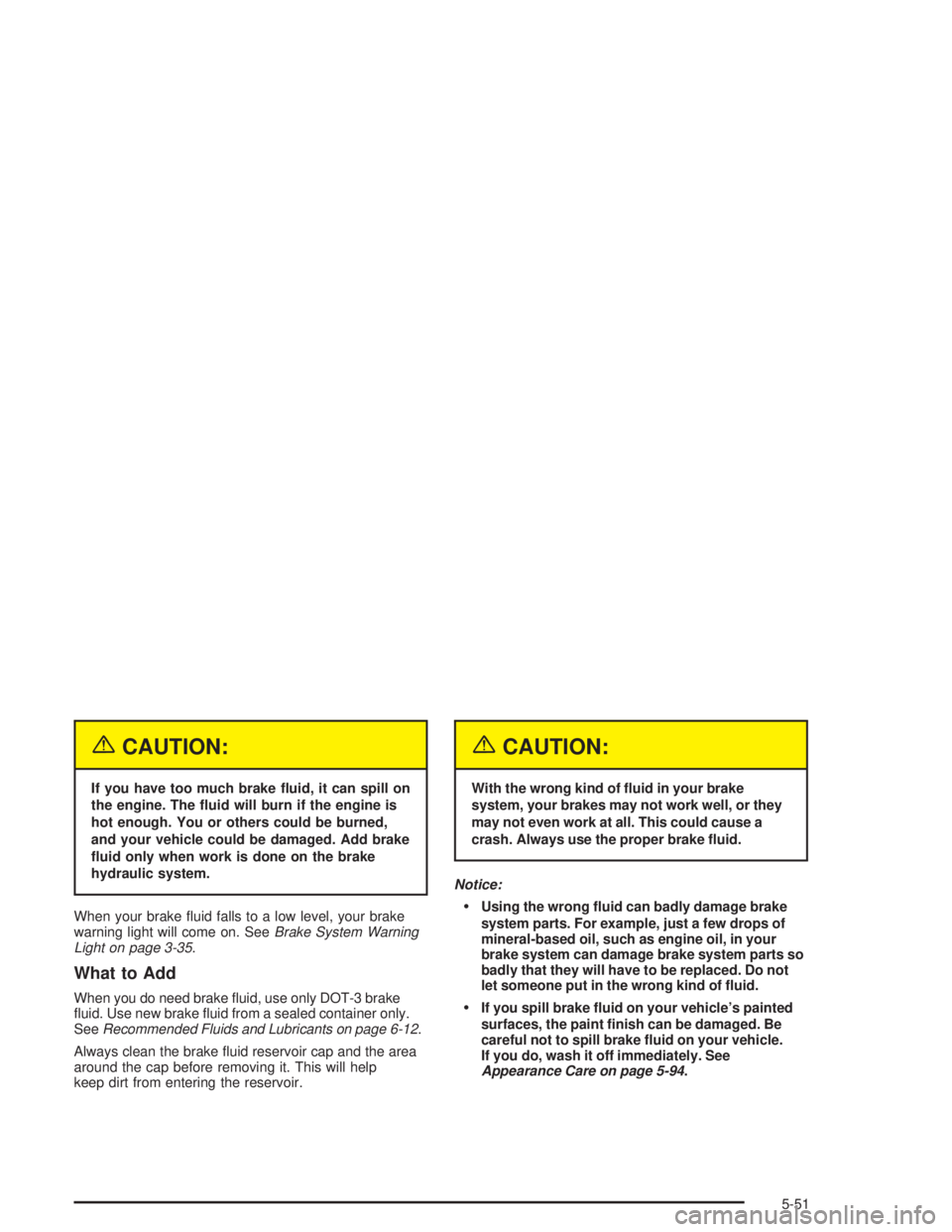
{CAUTION:
If you have too much brake �uid, it can spill on
the engine. The �uid will burn if the engine is
hot enough. You or others could be burned,
and your vehicle could be damaged. Add brake
�uid only when work is done on the brake
hydraulic system.
When your brake �uid falls to a low level, your brake
warning light will come on. SeeBrake System Warning
Light on page 3-35.
What to Add
When you do need brake �uid, use only DOT-3 brake
�uid. Use new brake �uid from a sealed container only.
SeeRecommended Fluids and Lubricants on page 6-12.
Always clean the brake �uid reservoir cap and the area
around the cap before removing it. This will help
keep dirt from entering the reservoir.
{CAUTION:
With the wrong kind of �uid in your brake
system, your brakes may not work well, or they
may not even work at all. This could cause a
crash. Always use the proper brake �uid.
Notice:
Using the wrong �uid can badly damage brake
system parts. For example, just a few drops of
mineral-based oil, such as engine oil, in your
brake system can damage brake system parts so
badly that they will have to be replaced. Do not
let someone put in the wrong kind of �uid.
If you spill brake �uid on your vehicle’s painted
surfaces, the paint �nish can be damaged. Be
careful not to spill brake �uid on your vehicle.
If you do, wash it off immediately. See
Appearance Care on page 5-94.
5-51